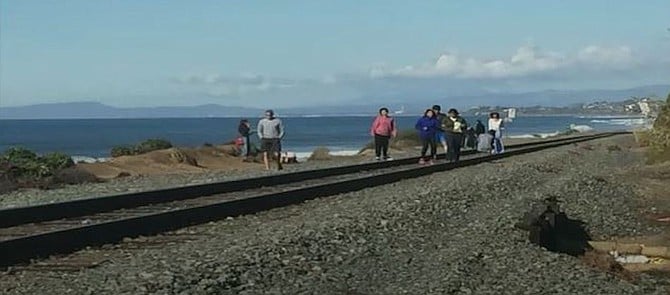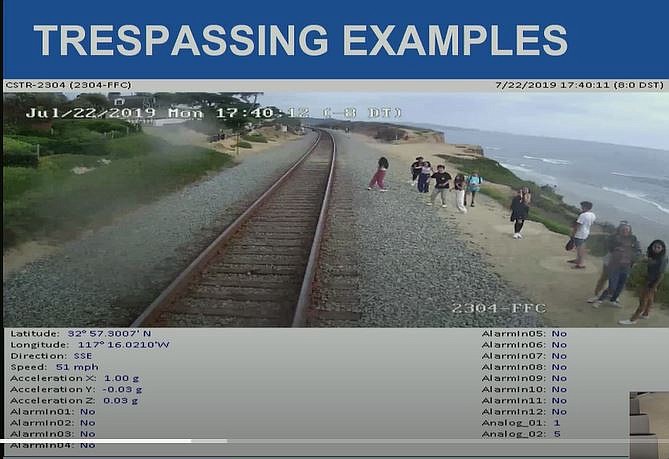 Facebook
Facebook
 X
X
 Instagram
Instagram
 TikTok
TikTok
 Youtube
Youtube

Del Mar officials want the trains off the bluffs. Transit officials want the people off the tracks. Neither side is succeeding, and with the number of trains increasing from 50 to 79 this year, the threat of accidents hangs over both.
Last year, a lawsuit filed by the family of a man struck and killed as he crossed the tracks accused the city of Del Mar and the railroads of failing to provide safe crossings like tunnels and bridges.

But as a multi-year project gets underway to stabilize the bluffs to make travel safer for trains, the only plan to make things safer for pedestrians is more signs and enforcement.
During recent repair work, trespassers were afoot, according to the North County Transit District, which claims the right-of-way along the 1.5 mile stretch of bluffs.
It's the same sweep of tracks locals have crossed to get to the beach for as long as anyone remembers. And before that, there was a deed, they say – which still gives them the right to cross in certain areas.
"All rights North County Transit District or the railway have to the bluffs upon which the tracks lie are subject to the provisions of this deed," Tom Grindle, a Del Mar local and attorney, told the city in 2018 when the trespassing issue was heating up again.
Since then, only the bluffs have changed, crumbling into the sea in six major collapses.
Trespassing reports, combined for 2018 and 2019, peaked in November: 170 incidents from Coast Blvd all the way down the bluffs, a transit district spokesperson told the city council last week during a safety presentation.
The incidents have involved as many as 50 people at one time. Most reports are filed by the train crews. Some were fatalities. Since 2015, there have been seven deaths.
Then there are the near misses that caused slowing or emergency braking; 34 since 2017. And behind every delayed train is a cascade of service disruption. The last five accidents in Del Mar held up 35 trains, annulled eight, and caused others to miss multiple stations.
The district has even calculated how much time these cost; 1,459 minutes, 5,250 passengers disrupted.
While it may seem easy to avoid being hit, rail officials offer a warning. The trains are quiet, can travel over 50 mph, and have a wider reach beyond the rails than people realize. The public lacks the training employees receive.
But the transit district's solution, a proposal to fence off the tracks, didn't survive public outrage over being blocked from all but the one legal crossing at 15th Street. That was when Grindle got involved.
In 1909, the city’s founder, the South Coast Land Company, granted the railway the land for its tracks. They reserved the right for access to the beach over the tracks in between 10th and 11th streets, Grindle said. The deed also allows "passageways to the ocean beach."
Grindle attached the deed in a letter to the city council so they could consider using it, in court if necessary, "in pointing out to North County Transit District that it does not have the legal right to block our bluff and beach access."
The council rejected the fence, instead working on more safe rail crossings. But the "Safe Rail Trail and Pedestrian Crossing feasibility study," which brought together the city, North County Transit District, and the San Diego Association of Governments, didn't get far.
What is in the works is a trespasser mitigation study by the transit district, which is "fully committed" to snuffing out the risky behavior. A draft will be released in March.
Other measures include more "no trespassing" and suicide prevention signs, more training for crews on reporting criteria, and increased presence of law enforcement.
The city can help, they say, by putting signs at all public access points to discourage trespassing, and closing off the trails from Powerhouse Park and the highway 101 overpass bridge leading to the right-of-way.
Actual hits and close calls haven't stopped people from taking shortcuts to the beach, which deputy mayor Terry Gaasterland says are well known as a recreational area.
Robert Hajek, another local attorney, said he was anxious to argue in court on behalf of people who have been getting ticketed for crossing the tracks.
"I believe this issue has to be dealt with by the city." It's a difficult one, he said, "because you have to prove you're a resident of the city to cross."


Del Mar officials want the trains off the bluffs. Transit officials want the people off the tracks. Neither side is succeeding, and with the number of trains increasing from 50 to 79 this year, the threat of accidents hangs over both.
Last year, a lawsuit filed by the family of a man struck and killed as he crossed the tracks accused the city of Del Mar and the railroads of failing to provide safe crossings like tunnels and bridges.

But as a multi-year project gets underway to stabilize the bluffs to make travel safer for trains, the only plan to make things safer for pedestrians is more signs and enforcement.
During recent repair work, trespassers were afoot, according to the North County Transit District, which claims the right-of-way along the 1.5 mile stretch of bluffs.
It's the same sweep of tracks locals have crossed to get to the beach for as long as anyone remembers. And before that, there was a deed, they say – which still gives them the right to cross in certain areas.
"All rights North County Transit District or the railway have to the bluffs upon which the tracks lie are subject to the provisions of this deed," Tom Grindle, a Del Mar local and attorney, told the city in 2018 when the trespassing issue was heating up again.
Since then, only the bluffs have changed, crumbling into the sea in six major collapses.
Trespassing reports, combined for 2018 and 2019, peaked in November: 170 incidents from Coast Blvd all the way down the bluffs, a transit district spokesperson told the city council last week during a safety presentation.
The incidents have involved as many as 50 people at one time. Most reports are filed by the train crews. Some were fatalities. Since 2015, there have been seven deaths.
Then there are the near misses that caused slowing or emergency braking; 34 since 2017. And behind every delayed train is a cascade of service disruption. The last five accidents in Del Mar held up 35 trains, annulled eight, and caused others to miss multiple stations.
The district has even calculated how much time these cost; 1,459 minutes, 5,250 passengers disrupted.
While it may seem easy to avoid being hit, rail officials offer a warning. The trains are quiet, can travel over 50 mph, and have a wider reach beyond the rails than people realize. The public lacks the training employees receive.
But the transit district's solution, a proposal to fence off the tracks, didn't survive public outrage over being blocked from all but the one legal crossing at 15th Street. That was when Grindle got involved.
In 1909, the city’s founder, the South Coast Land Company, granted the railway the land for its tracks. They reserved the right for access to the beach over the tracks in between 10th and 11th streets, Grindle said. The deed also allows "passageways to the ocean beach."
Grindle attached the deed in a letter to the city council so they could consider using it, in court if necessary, "in pointing out to North County Transit District that it does not have the legal right to block our bluff and beach access."
The council rejected the fence, instead working on more safe rail crossings. But the "Safe Rail Trail and Pedestrian Crossing feasibility study," which brought together the city, North County Transit District, and the San Diego Association of Governments, didn't get far.
What is in the works is a trespasser mitigation study by the transit district, which is "fully committed" to snuffing out the risky behavior. A draft will be released in March.
Other measures include more "no trespassing" and suicide prevention signs, more training for crews on reporting criteria, and increased presence of law enforcement.
The city can help, they say, by putting signs at all public access points to discourage trespassing, and closing off the trails from Powerhouse Park and the highway 101 overpass bridge leading to the right-of-way.
Actual hits and close calls haven't stopped people from taking shortcuts to the beach, which deputy mayor Terry Gaasterland says are well known as a recreational area.
Robert Hajek, another local attorney, said he was anxious to argue in court on behalf of people who have been getting ticketed for crossing the tracks.
"I believe this issue has to be dealt with by the city." It's a difficult one, he said, "because you have to prove you're a resident of the city to cross."
Comments